
Melonworm Update September 30th, 2024
It’s been almost two months since we first found melonworm near Ft. Smith and Hope. Finding melonworm in Arkansas pumpkins this early is not the norm and indicated to us a significant risk of widespread impact to the pumpkin crop. We have since watched the melonworm population increase in density and impact, and now going into October we have found it in every pumpkin patch that we’ve looked (in all cases growers thought they had no melonworm) (Picture 1). This indicates to us that the risk of infestation on all Midsouth pumpkin plantings is very high, and all growers need to be applying insecticides to avoid major fruit injury in the next few weeks.
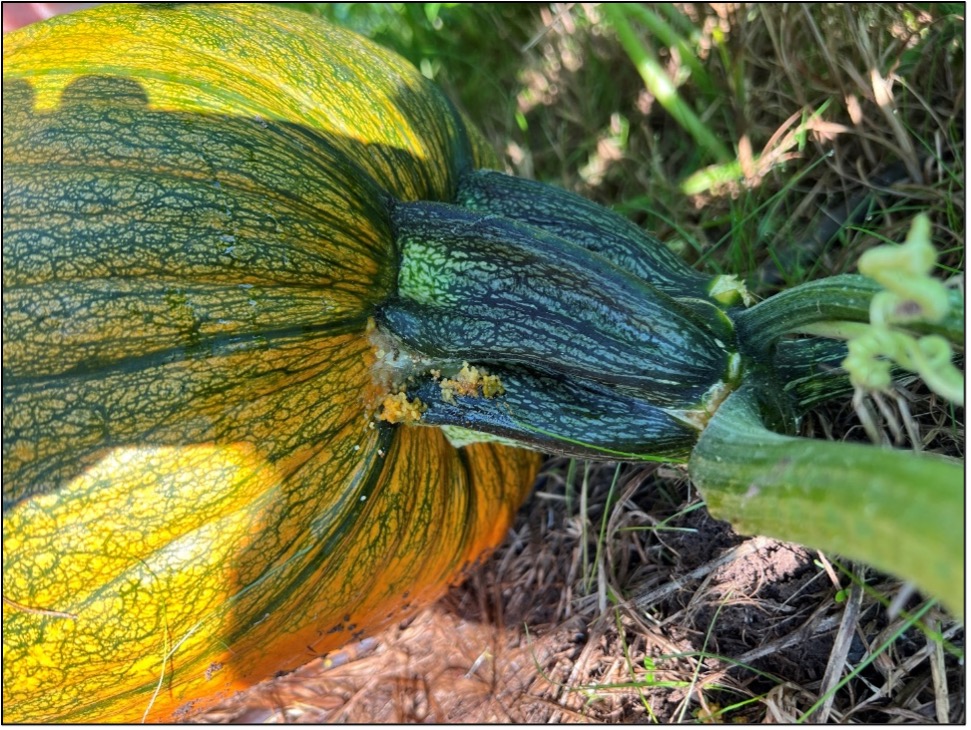
Picture 1 – Melonworm feeding on a jack-o-lantern pumpkin at a pumpkin patch near Little Rock, AR on 9/19/2024. This grower had sprayed within the last 7 days with a pyrethroid insecticide, and larvae that were observed likely hatched after residual activity had lapsed or survived due to poor insecticide coverage. Picture by Aaron Cato.
Who’s at the Highest Risk?
Growers who run agritourism operations are extremely hesitant to apply insecticides on their off days when much of the week features the public being amongst plants. These growers are at the greatest risk of widespread fruit injury, and where we have already found melonworm feeding on fruit in the last two weeks at the operations we scouted in Central Arkansas. I encourage everyone to look at our data below to see how quickly this pest can take over unsprayed plantings (variety trial) and how little melonworm we see when insecticides are consistently used (pesticide trial). The use of diamide insecticides (Coragen, Shenzi, or Besiege) can give 21 days of good residual control, while being a very safe insecticide to use with extremely short re-entry intervals and pre-harvest intervals. Coragen and Shenzi can even be applied through chemigation with a drip irrigation setup and still effectively control larvae as they hatch out of eggs and feed on leaves, requiring no spraying of the plants at all. In fact, even the consistent usage of Bt has successfully suppressed melonworm in our trials. Successful control will require excellent spray coverage, especially when considering pyrethroid insecticides or Bt that have short residuals.
What’s the Melonworm Risk Right Now?
Moths are currently laying eggs on all parts of plants, and growers should expect anything unsprayed to be at risk. What we’ve seen is that even though insecticides like pyrethroids effectively kill melonworm, many are breaking through and getting to fruit. Due to the high infestation levels, any plant material that is missed will lead to larvae not dying once hatched, and they will quickly move from leaves to the fruit once plants are mature. In our trials we have plants that have been completely defoliated, with several larvae per plant (Picture 2 and 3), really exemplifying the infestation pressure we are experiencing. In our trials near Ft. Smith, we observed over 100 moths while scouting only ~300 row ft of pumpkins. The good thing is that larvae are feeding on leaves a small amount before moving to fruit. This means that they will encounter and ingest pesticide residue if they encounter well covered plants.
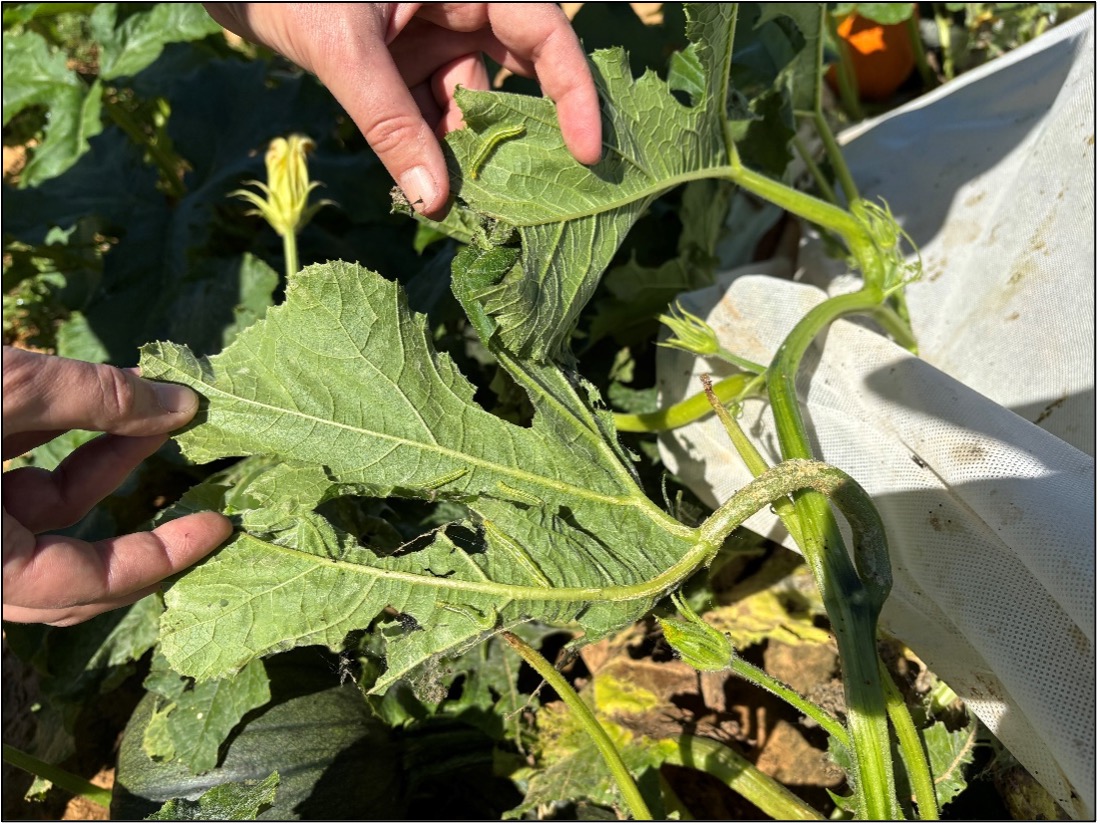
Picture 2 – Melonworm larvae on a later planted pie pumpkin plant (~July 10th) in Hope, AR on 9/26. At least five larvae can be observed on these two leaves alone, indicating extremely high infestation pressure from melonworm. Picture by Ryan Keiffer.
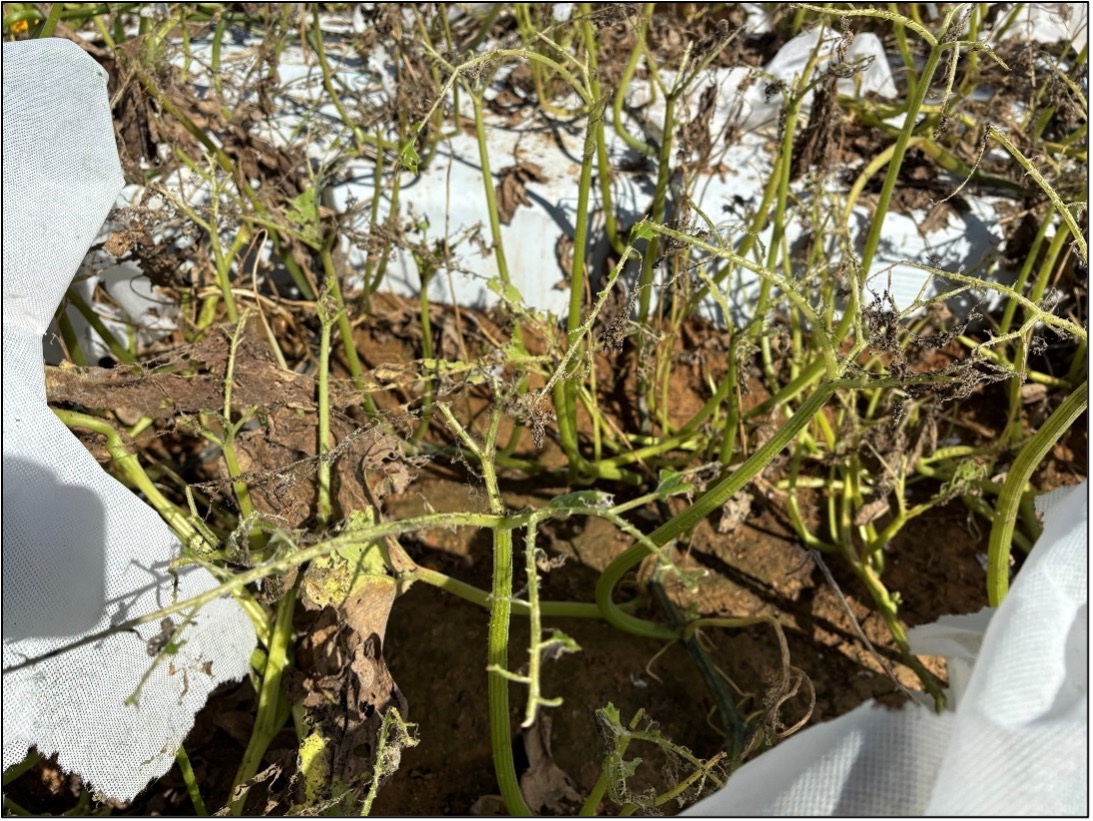
Picture 3. Pie pumpkins that have been completely defoliated by melonworm larvae in Hope, AR. These plants were originally covered by 2-ounce row covers to protect from melonworm infestation, however row covers broke down due to high moisture and heat in only a few weeks. Picture by Ryan Keiffer on 9/26.
Preliminary Results of 2024 Pumpkin Trials
Pumpkin Varieties at Risk
Below is data from our research plots in the two locations we first found melonworm (Figure 1 and 2). Results from our variety trial show that differences do exist in which pumpkin varieties and species melonworm is attracted to, both when considering the density of melonworm larvae observed on plants and the number of fruit being fed on. Across the board jack-o-lantern varieties from C. pepo are most attractive to melonworm and are at the highest risk. Varieties we tested from three other Cucurbita species exhibited 3-4x less worms on plants, and less than 10% fruit loss in all cases except for ‘Fairytale’. I think what this tells us is that a lot of our ornamental varieties may not be at quite as high of a risk. This does not hold true for any ornamental variety derived from C. pepo, including many of the warty jacks, white jacks, etc.
Pesticide Strategies for Control
Our data indicate that scouting for melonworm to indicate control with insecticides is the most sustainable way to control this pest. We scouted once per week and started spraying for melonworm once they were observed in the field in both Kibler and Hope. We considered applications each week based on presence of melonworm and the expected residual of products used. Untreated plots never got a spray, and we ended up with over 15% damaged fruit. Based on what we saw in the variety trial its possible this number would have been more like 50-70% if not surrounded by plots where effective pesticides were being used. For our scouting based treatments, we made an application each week for the organic option (Bt – Dipel) and the pyrethroid (lambda cyhalothrin- Warrior II), and both did a pretty good job with 0-5% damaged fruit observed. This required weekly sprays, amassing 6 consecutive weeks of spraying prior to this data being collected, whereas our scouting-based Chlorantraniliprole (Coragen) only required two sprays (21 days of residual expected) and had 0% damaged fruit in that same time. We also were asked by growers about a calendar based 2 spray solution of chlorantraniliprole considering just under a month of residual control. We timed this treatment for September 1st and October 1st applications, and what the data show is that in years when melonworm come early (such as this year) you should expect to see damage prior to the September 1st spray, whereas that 5% of damaged fruit can be prevented simply by scouting weekly prior to September 1st.
The takeaway from these data is that there are solutions for control of this pest, with many of these solutions being very targeted and safe insecticides that don’t have as much concern for residue like a pyrethroid may. Growers should consider spraying anything, even Bt, as our data shows you will prevent over 10% of your fruit being damaged, and likely more.
Give me a call anytime if you have any questions. Aaron Cato – 479-249-7352
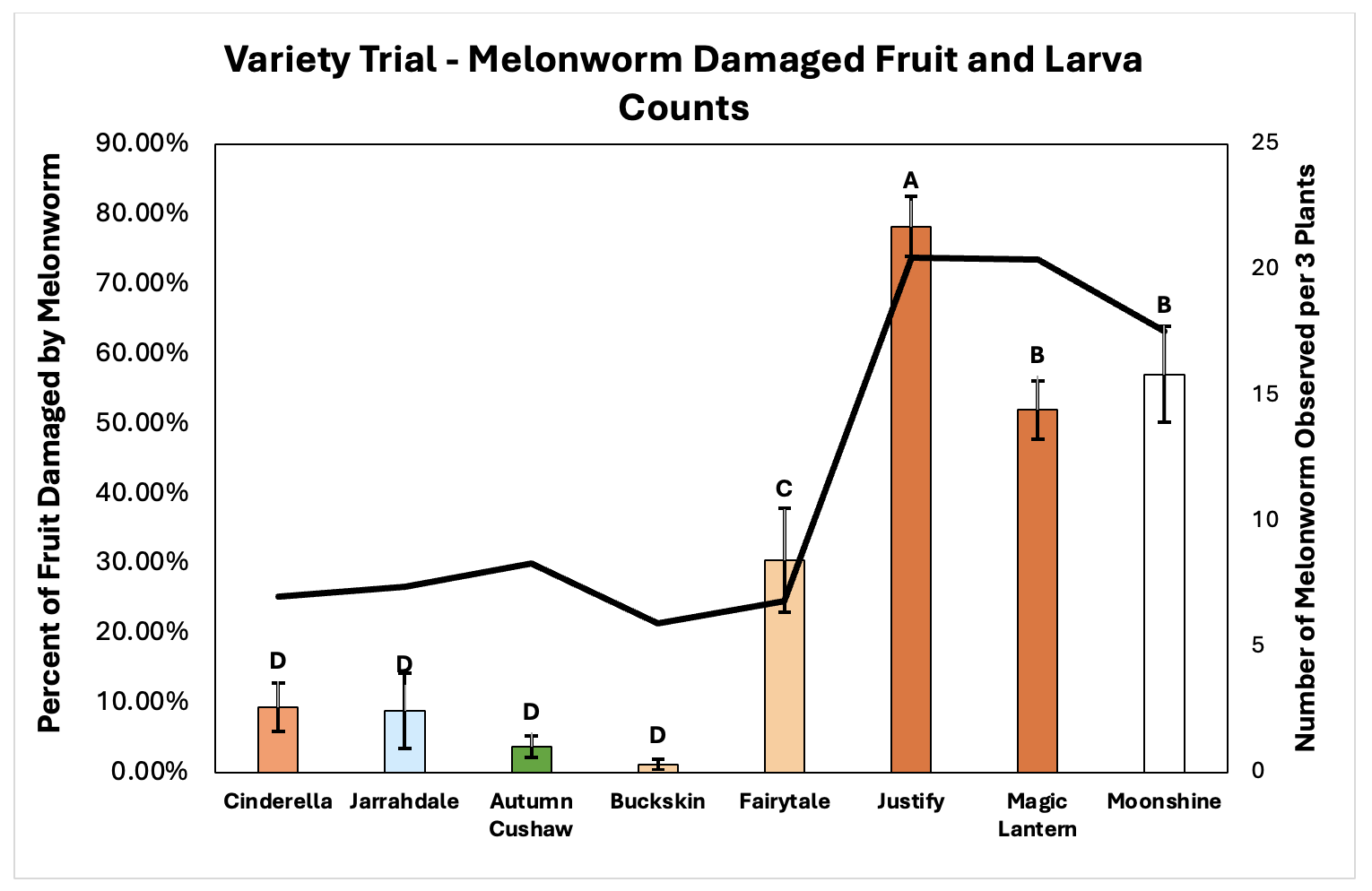
Figure 1. Results from our 2024 variety trials that shows the percent of fruit damaged by melonworm in each variety (pumpkin-colored bars) and number of melonworm observed on plants at the time of harvest (black line) in Hope and Kibler, AR. Varieties derived from Cucurbita maxima (‘Cinderella’ and ‘Jarrahdale’), Cucurbita mixta (‘Autumn Cushaw’), and Cucurbita moschata (‘Buckskin’ and ‘Fairytale’) exhibited significantly fewer damaged fruit than varieties derived from Cucurbita pepo (‘Justify’, ‘Magic Lantern’, and ‘Moonshine’). Elevated fruit damage was observed in ‘Fairytale’, which is derived from the same species as ’Buckskin’. Melonworm were observed on plants of all 8 varieties and 4 different species of Cucurbita, although numbers were 3-4 times higher in jack-o-lantern varieties derived from Cucurbita pepo. Although no difference in melonworm observed existed between all non-C. pepo varieties, melonworm still heavily damaged fruit in ’Fairytale’.
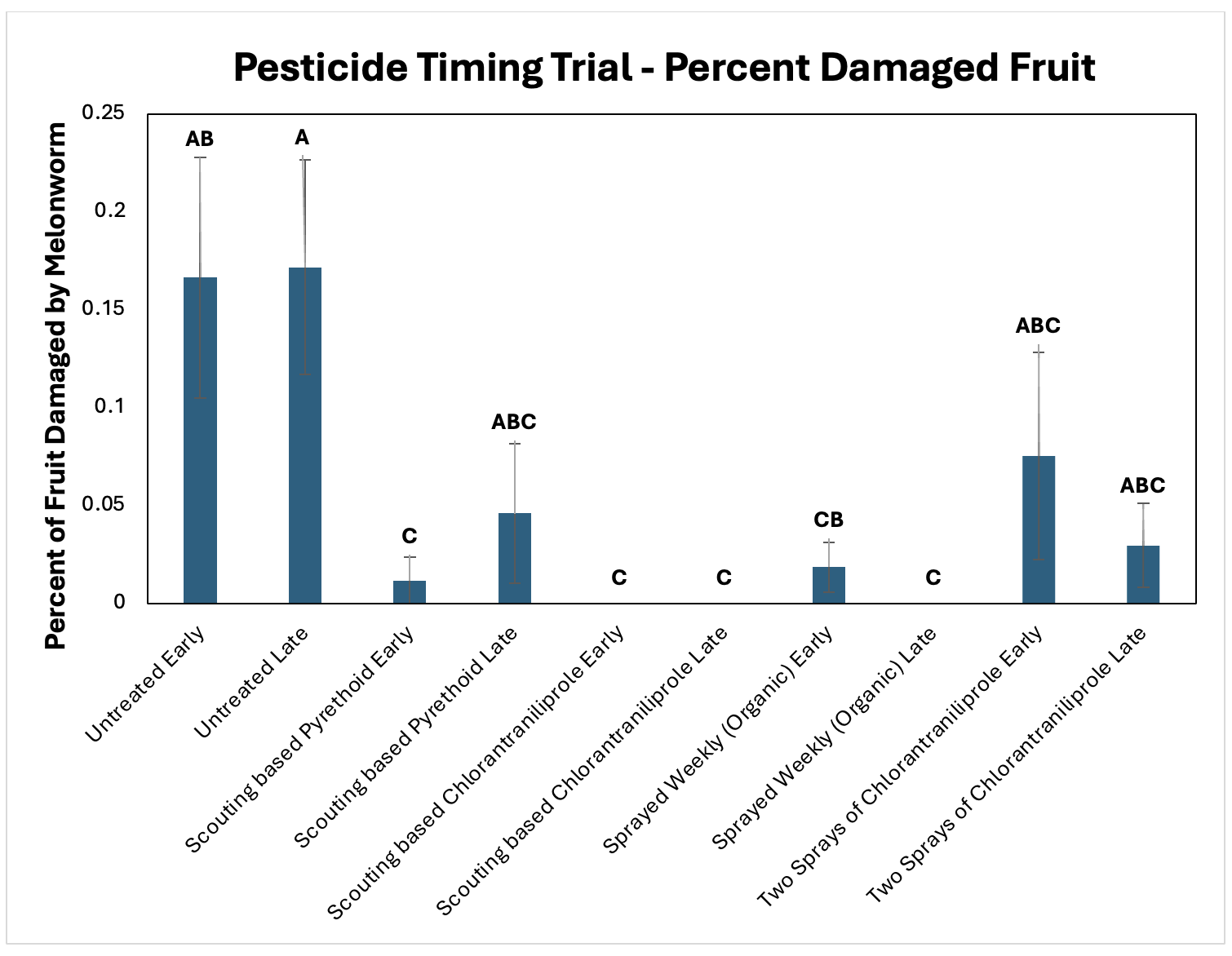
Figure 2. Results from our pesticide timing trials that show the percent of fruit damaged by melonworm for each pesticide treatment in Hope and Kibler, AR in 2024. For each pesticide treatment an “Early” or “Late” planting date was assessed. Untreated plots were never sprayed, scouting based sprays of pyrethroids received 6 applications of lambda cyhalothrin (Warrior II), scouting based sprays of an organic product received 6 applications of Bt (Dipel), scouting-based Chlorantraniliprole received two sprays of Coragen (21 days of residual expected), and finally a a calendar based 2 spray solution of chlorantraniliprole (Coragen) only received one application (September 1st).